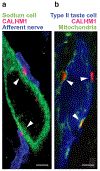Taste transduction and channel synapses in taste buds
- PMID: 32936320
- PMCID: PMC9386877
- DOI: 10.1007/s00424-020-02464-4
Taste transduction and channel synapses in taste buds
Abstract
The variety of taste sensations, including sweet, umami, bitter, sour, and salty, arises from diverse taste cells, each of which expresses specific taste sensor molecules and associated components for downstream signal transduction cascades. Recent years have witnessed major advances in our understanding of the molecular mechanisms underlying transduction of basic tastes in taste buds, including the identification of the bona fide sour sensor H+ channel OTOP1, and elucidation of transduction of the amiloride-sensitive component of salty taste (the taste of sodium) and the TAS1R-independent component of sweet taste (the taste of sugar). Studies have also discovered an unconventional chemical synapse termed "channel synapse" which employs an action potential-activated CALHM1/3 ion channel instead of exocytosis of synaptic vesicles as the conduit for neurotransmitter release that links taste cells to afferent neurons. New images of the channel synapse and determinations of the structures of CALHM channels have provided structural and functional insights into this unique synapse. In this review, we discuss the current view of taste transduction and neurotransmission with emphasis on recent advances in the field.
Keywords: CALHM; Ion channel; Sensory; Synapse; Taste.
Conflict of interest statement
Figures



References
-
- Adler E, Hoon MA, Mueller KL, Chandrashekar J, Ryba NJ, Zuker CS (2000) A novel family of mammalian taste receptors. Cell 100:693–702 - PubMed
-
- Anand KK, Zuniga JR (1997) Effect of amiloride on suprathreshold NaCl, LiCl, and KCl salt taste in humans. Physiol Behav 62:925–929 - PubMed
-
- Bigiani A (2017) Calcium homeostasis modulator 1-like currents in rat fungiform taste cells expressing amiloride-sensitive sodium currents. Chem Senses 42:343–359 - PubMed
Publication types
MeSH terms
Grants and funding
LinkOut - more resources
Full Text Sources
Other Literature Sources
Medical

